Product Images Zonisamide
View Photos of Packaging, Labels & Appearance
- image description - Chart
- image description - Label
- image description - Molecule
- image description - Picture
- image description - Picture2
- image description - Table1
- image description - Table2
- image description - Table3
- image description - Table4 1
- image description - Table4 2
- image description - Table4 3
- image description - Table4 4
- image description - Table5
Product Label Images
The following 13 images provide visual information about the product associated with Zonisamide NDC 61919-591 by Direct Rx, such as packaging, labeling, and the appearance of the drug itself. This resource could be helpful for medical professionals, pharmacists, and patients seeking to verify medication information and ensure they have the correct product.
image description - Chart
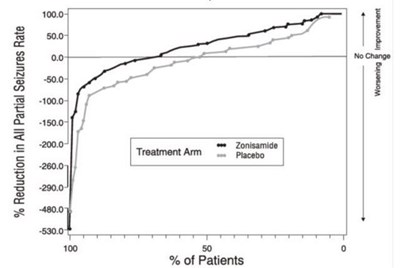
This data shows the percentage reduction in all partial seizures rate for patients taking either TAm or Zonisamide. The range of reduction is between -150.0% to 100.0%, with approximately half of the patients experiencing a 50% or greater reduction in partial seizures. No further information is available to provide context for these results.*
image description - Label
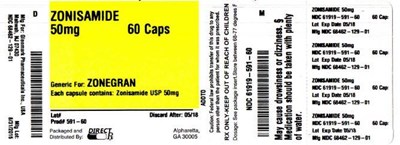
This appears to be a description of a medication called Zonisamide, which is a generic form of the drug Zonegran. Each capsule contains 50mg of Zonisamide USP. The information also includes the product code and quantity (60 capsules). However, there is some unclear and potentially incorrect text so caution should be taken if using this information for medical purposes.*
image description - Picture2

This is a label of a medication that has been manufactured by Glenmark Pharmaceuticals Inc. in Mahwah, NJ. The label provides contact information for questions and inquiries, including a phone number and website. The label also includes the month and year of manufacture, which is July 2015.*
image description - Table1
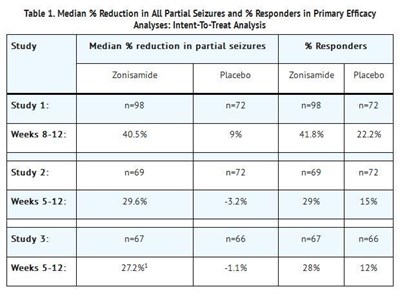
The text provides a table that shows the median % reduction in all partial seizures and % responders in primary efficacy analyses for three studies conducted with zonisamide and placebo over a period of weeks 8-12 or 5-12. Study 1 shows that zonisamide had a higher % reduction in partial seizures as compared to placebo with a higher % responder rate. Study 2 also favors the effect of zonisamide over placebo, although the difference is not as prominent as in Study 1. The results of Study 3, however, suggest that zonisamide is less effective in reducing the seizures as compared to placebo with lower % responders.*
image description - Table2
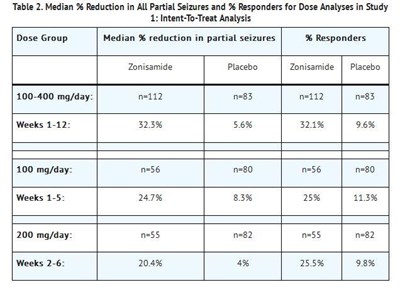
The text is a table showing the median percentage reduction in all partial seizures and percentage responders for different doses of Zonisamide compared to Placebo. The data is obtained from a study which analyzed the effect of different doses of Zonisamide and Placebo on partial seizures over weeks 1 to 12. At doses of 100-400 mg/day, Zonisamide showed a median % reduction in partial seizures of 323%, while Placebo showed a reduction of 56%. The same dose group also had a % responder rate of 321% for Zonisamide versus 9.6% for Placebo. However, at 100 mg/day and 200 mg/day, Zonisamide showed lower median % reduction of 247% and 204% respectively compared to Placebo. The % responders rate for Zonisamide was also lower for both these dose groups compared to Placebo.*
image description - Table4 1
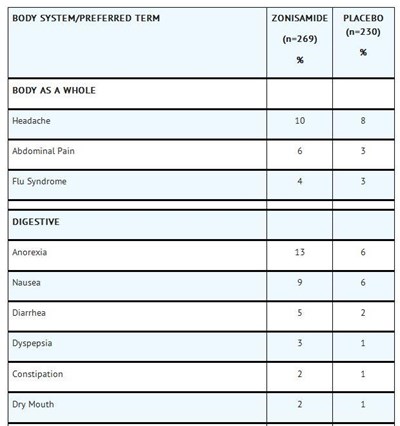
This text appears to describe some sort of medical study or clinical trial involving a medication called "Zonisamide" and a placebo. The text includes a table that shows the frequency of various symptoms experienced by participants who took either the medication or the placebo. These symptoms are grouped by body system and include headache, abdominal pain, flu-like symptoms, digestive issues such as nausea and diarrhea, and dry mouth.*
image description - Table4 2
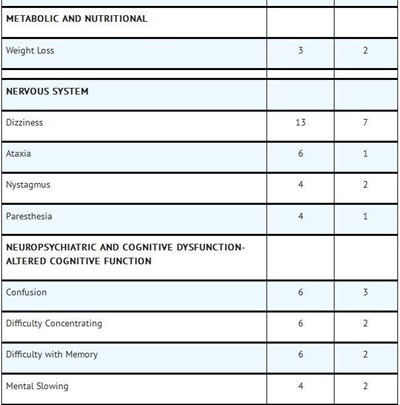
This is a list of symptoms related to metabolism, nutrition, and the nervous system. These symptoms include weight loss, dizziness, ataxia (lack of muscle coordination), nystagmus (involuntary eye movements), and paresthesia (tingling sensations). There are also some neuropsychiatric and cognitive symptoms, such as confusion, difficulty concentrating, difficulty with memory, and mental slowing.*
image description - Table4 3
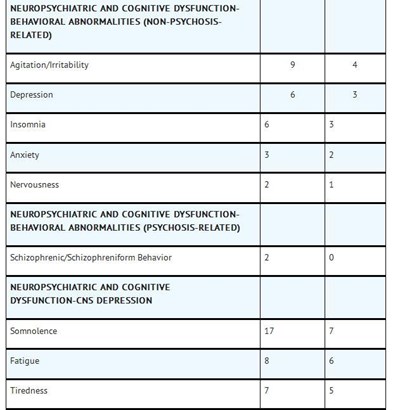
This text describes different types of neuropsychiatric and cognitive dysfunction associated with behavioral abnormalities. The first section lists symptoms such as agitation, irritability, depression, insomnia, anxiety, and nervousness. The second section highlights psychosis-related behavioral abnormalities, such as schizophrenic or schizophreniform behavior. The final section focuses on CNS depression, which can lead to symptoms such as somnolence, fatigue, and tiredness.*
image description - Table4 4
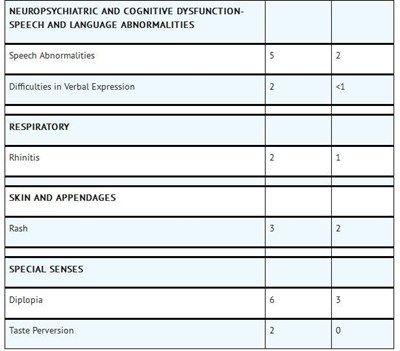
This text appears to be a list of symptoms related to neuropsychiatric and cognitive dysfunction, including speech and language abnormalities, difficulties in verbal expression, respiratory issues such as rhinitis, skin rash, special senses issues such as diplopia (double vision) and taste perversion.*
image description - Table5
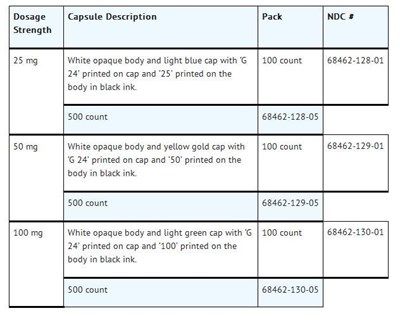
This is a medication description for capsules with different strengths of 25mg, 50mg, and 100mg. Each capsule has a different color and markings for identification. The capsules come in packs of either 100 or 500 and are identified by their respective NDC numbers.*
* The product label images have been analyzed using a combination of traditional computing and machine learning techniques. It should be noted that the descriptions provided may not be entirely accurate as they are experimental in nature. Use the information in this page at your own discretion and risk.


